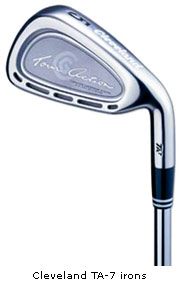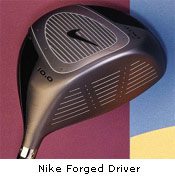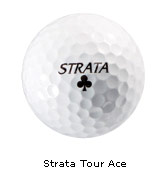|
 GOLF EQUIPMENT GOLF EQUIPMENT
Golf manufacturers
surging after eventful year
By Shane Sharp,
Contributing Writer
CHARLOTTE, N.C. (Jan. 6, 2002) -- The meteoric rise in golf equipment sales finally flatlined a bit in 2002 as a struggling economy and luke warm golf travel market combined to suppress golfers' desires for the hottest new clubs and balls. No one, however, was ready to pronounce the industry dead on arrival. Cleveland, Callaway, Titleist, MaxFli and a handful of manufacturers weathered the storm in style. Cleveland - known primarily for its best-selling wedges - made a big splash in a saturated iron market with its TA-7 line. Titleist and MaxFli cornered opposite ends of the golf ball market, the former with its revamped high-end Pro V-1* and the later with its affordable Noodle ball. And Callaway Golf, via its subsidiary company, Odyssey, cashed in with the White Hot 2-ball putter, which found its way into the bags of no less than 67 PGA Tour players. J.R. Barrier, manager of Martin's Golf and Tennis Super Store in North Myrtle Beach, S.C., says that a number of other items were flying off the shelves at the Grand Strand's largest equipment retailer in 2002. "Nicklaus Golf has to be the hottest thing in the store, in terms of clubs," Barrier says. "The Taylor Made 420 Burner series metal woods just came out and they are hot, too. The Odyssey White Hot 2-Ball putter always does well, and we sell lots of Cleveland and Titleist Vokey wedges." Nicklaus Golf's Airmax 360 Superbeta Driver was all the rage in 2002, and the company recently introduced its new Airmax 430-S Superbeta Driver. The club features a 430-cc head loaded with the maximum allowable coefficient of resistance - the controversial spring-like effect that sends well-struck tee shots into the next zip code. Nicklaus himself claims to hit the ball 20 yards farther with the Airmax 360, and the Golden Bear has gone on record as expecting to milk even more distance out of the 430-S.  Speaking of length off the tee, Tiger Woods still hits the ball a fair distance, and any discussion of Woods begins and ends with Nike Golf. Nike entered the golf club fray in 2002 with its Forged Titanium Driver and muscleback irons, both aimed at low handicappers and professionals. This year, it is targeting the average golfer with its Pro Combo irons, which feature perimeter weighting in the long irons and graduate to a muscleback clubhead in the short irons. Nike has also entered the fairway wood and wedge wars with its Forged Wedge and T-40 lines, respectively, and plans are in the works for a new line of putters. Speaking of length off the tee, Tiger Woods still hits the ball a fair distance, and any discussion of Woods begins and ends with Nike Golf. Nike entered the golf club fray in 2002 with its Forged Titanium Driver and muscleback irons, both aimed at low handicappers and professionals. This year, it is targeting the average golfer with its Pro Combo irons, which feature perimeter weighting in the long irons and graduate to a muscleback clubhead in the short irons. Nike has also entered the fairway wood and wedge wars with its Forged Wedge and T-40 lines, respectively, and plans are in the works for a new line of putters.
While it doesn't get as much ink as Cleveland or Nike, Yonex has traditionally been one of the industry's top manufactures of irons and metal woods. Scott Hoch, one of the PGA Tour's best ball strikers, seems to have the utmost confidence in the clubs. Sales associate Russ Williams says it's all about Yonex's individual clubmaking philosophy. "We are the only company that I know of that makes the heads, shafts, and grips," he says. "We don't rely on one thing from one company and another from another."
For 2003, Yonex will focus on its V-Mass 400 line of drivers and fairway woods, and its new line of V-Mass 400 irons. The 400 series irons are a follow up to the popular 350 and 260 series and are available in both men's and women's sets. Yonex was the first manufacturer to use graphite in golf club shafts, and in 2003 the company will look to improve upon its UL-Ti shafts. The revolutionary shafts are made up of a titanium and nickel blend that provides more strength and less torque, adding five to six miles per hour to average golfer's swing speeds. Cleveland Golf officials say they plan to stick with the TA-7 in 2003, albeit a slightly tricked up version. Last fall, the company quietly introduced the TA-7 Tour Mico-Cavity irons, which feature a smaller, softer and less offset clubhead geared towards lower handicap players who prefer ac curacy over power. There's also talk of expanding the TA-3 iron prototype iron developed for PGA Tour player David Toms. Also in the works at Cleveland Golf is a new line of clubs for juniors, a dot-based wedge system that will enable golfers to easily select wedges with the proper amount of bounce, and a 58-degree edit of the company's venerable 588 Tour Spin wedge. Time was, Ping and Callaway were the only names you needed to know in the world of drivers, fairway woods and irons. Times have changed, but the two equipment behemoths haven't raised the white flag by any means. Ping recently introduced the i3+ iron line and Callaway redesigned its Big Bertha irons with a wide sole and more perimeter weighting.  On the other side of the equipment equation, the golf ball market will be as active as ever in 2003. Spalding has new products queued up for its Strata, Top Flite and Hogan lines. Top Flite introduced its "Tour" ball in late 2002, a three-piece, 66 compression ball that retails for around $20 a dozen. Strata, Spalding's high end product, unveiled its Tour Ace and Tour Ultimate. The Tour Ace is a four-piece ball, multi-layer ball that is stamped with playing card suites in lieu of numbers, and the Tour Ultimate is a high launch, easy to spin model that is ideal for mid to high handicappers. On the other side of the equipment equation, the golf ball market will be as active as ever in 2003. Spalding has new products queued up for its Strata, Top Flite and Hogan lines. Top Flite introduced its "Tour" ball in late 2002, a three-piece, 66 compression ball that retails for around $20 a dozen. Strata, Spalding's high end product, unveiled its Tour Ace and Tour Ultimate. The Tour Ace is a four-piece ball, multi-layer ball that is stamped with playing card suites in lieu of numbers, and the Tour Ultimate is a high launch, easy to spin model that is ideal for mid to high handicappers.
Not to be outdone, Nike followed up its high end Tour Accuracy ball with the new TA-2, available in both long (LNG) and high spin (SPN) editions. The TA-2 features new core and cover technology that increases spin and speed off the club face. Titleist, the industry leader in golf ball sales, is still basking in the success the Pro-V1*, but the company is launching the new Pro-V1 H ball in 2003, aimed at low handicappers. Contributing Writer Shane Sharp covers equipment for WorldGolf.com and TravelGolf.com. Comment on this story on our reader feedback page.
Agree with this review? Disagree?
Post your thoughts at GolfBoards.com.
|
 On the other side of the equipment equation, the golf ball market will be as active as ever in 2003. Spalding has new products queued up for its Strata, Top Flite and Hogan lines. Top Flite introduced its "Tour" ball in late 2002, a three-piece, 66 compression ball that retails for around $20 a dozen. Strata, Spalding's high end product, unveiled its Tour Ace and Tour Ultimate. The Tour Ace is a four-piece ball, multi-layer ball that is stamped with playing card suites in lieu of numbers, and the Tour Ultimate is a high launch, easy to spin model that is ideal for mid to high handicappers.
On the other side of the equipment equation, the golf ball market will be as active as ever in 2003. Spalding has new products queued up for its Strata, Top Flite and Hogan lines. Top Flite introduced its "Tour" ball in late 2002, a three-piece, 66 compression ball that retails for around $20 a dozen. Strata, Spalding's high end product, unveiled its Tour Ace and Tour Ultimate. The Tour Ace is a four-piece ball, multi-layer ball that is stamped with playing card suites in lieu of numbers, and the Tour Ultimate is a high launch, easy to spin model that is ideal for mid to high handicappers.  GOLF EQUIPMENT
GOLF EQUIPMENT  Speaking of length off the tee, Tiger Woods still hits the ball a fair distance, and any discussion of Woods begins and ends with Nike Golf. Nike entered the golf club fray in 2002 with its Forged Titanium Driver and muscleback irons, both aimed at low handicappers and professionals. This year, it is targeting the average golfer with its Pro Combo irons, which feature perimeter weighting in the long irons and graduate to a muscleback clubhead in the short irons. Nike has also entered the fairway wood and wedge wars with its Forged Wedge and T-40 lines, respectively, and plans are in the works for a new line of putters.
Speaking of length off the tee, Tiger Woods still hits the ball a fair distance, and any discussion of Woods begins and ends with Nike Golf. Nike entered the golf club fray in 2002 with its Forged Titanium Driver and muscleback irons, both aimed at low handicappers and professionals. This year, it is targeting the average golfer with its Pro Combo irons, which feature perimeter weighting in the long irons and graduate to a muscleback clubhead in the short irons. Nike has also entered the fairway wood and wedge wars with its Forged Wedge and T-40 lines, respectively, and plans are in the works for a new line of putters.